| Prev | 3.4 Tab Guide | Next |
[ Display Tab | Light Tab | Labels Tab | PDB Search Tab | Meshes Tab ]
In this section we describe the contents of the tabs in the graphical user interface.

3.4.1 Display Tab |
The display tab contains tools for a variety of functions including - structural representations, coloring, labeling and superposition. This tab is shown below.
![]()
3.4.2 Light Tab |

The options in this tab are described in the Lighting Section.
3.4.3 Labels Tab |

The options in this tab are described in the labels section of this manual.
3.4.4 PDB Search Tab |
Instructions on how to use this tab can be found in the Search PDB section.
3.4.5 Meshes Tab |
[ Surfaces | Meshes | Macroshape | Google 3D | Mesh options | Move/Resize | Mesh/Display | Mesh Clipping | Save Mesh | Occlusion ]
| Note: Click Next (top right hand corner) to navigate through this chapter. Headings are listed on the left hand side (web version) or by clicking the Contents button on the left-hand-side of the help window in the graphical user interface. |
Click on the tab button entitled 'meshes' and three different graphical display tools are available for you to use. The three displays are surface, meshes and macroshape and are collectively referred to as meshes.

The benefits and applications of each display are described in this section.
Surface:
 Meshes:
Meshes:
 Macroshape:
Macroshape:
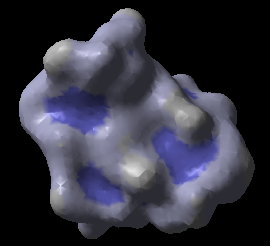
3.4.5.1 Surfaces |
The surface of your structure can be displayed and colored by electrostatics or binding properties. To do this:
- Load a structure into ICM File/Open or tab-pdb{PDB Search}
- Convert the structure into an ICM object.
- Select the 'meshes' tab button.
The buttons and options you need to use are shown below:

First you need to decide by what parameter you wish to color the surface:
- Click on the drop down arrow menu shown below and select which parameter you wish to color the surface by.
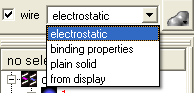
- Click the button next to the menu to color the surface of your molecule.
If you wish to have your surface displayed in wire check the 'wire' box next to the menu.
To display or undisplay the surface click in the box in the ICM workspace as shown below:
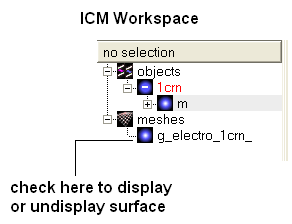
| NOTE: All surfaces, meshes and macroshapes come under the one heading of meshes in the workspace panel. |
3.4.5.2 Meshes and Macroshape |
A variety of shapes can be constructed using ICM. These shapes are referred to as meshes. The types of shapes you can build are shown below:
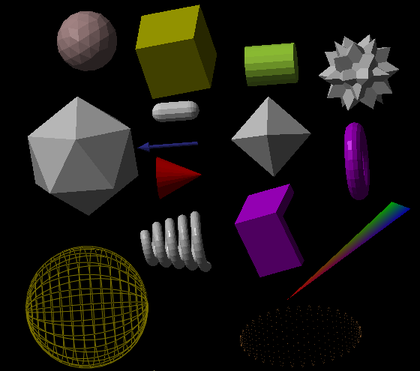
All the buttons for creating these shapes are shown here:
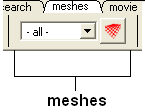
To make a shape select it from the menu by clicking on the down arrow and then click the button next to the menu. The shape will then be displayed in the 3D graphics window.
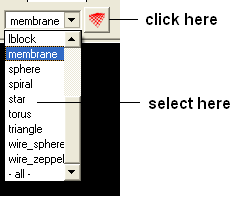
3.4.5.3 Macroshape |
A macroshape can be constructed and allows easy viewing and manipulation of the structural representation. A macroshape representation is ideal for large structures which allows the user to easily identify important regions of the structure and facilitate the return to the 'standard' view of a particular molecule. All the buttons needed to display a macroshape structure are shown below in the 'meshes' tab.
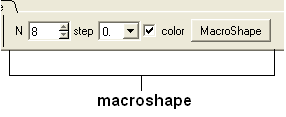
To construct a macroshape:
- Load a molecule into ICM File/Open or tab-pdb{PDB Search}
- Select the amount of detail required in the shape by increasing the values in 'N' or 'step' data entry box (note the default values are usually sufficient).
- Check the 'color' if you wish your molecule to be colored.
- Click the button labeled 'MacroShape'.
Macroshape can also be used from the View menu: View/Macro Shape
3.4.5.4 Google 3D Objects (Sketchup) |
To read in a 3D Mesh from Google in KMZ or COLLADA format:
- File/Load/ 3D Mesh in KMZ or COLLADA Format from Google
- Search for the object you would like to view and download it.
- To read the file go to File/Open
An example of a KMZ file can be found in the distribution (a squirrel model by ilikipie, provided with author's permission).
- File/Open, and choose the squirrel.kmz file
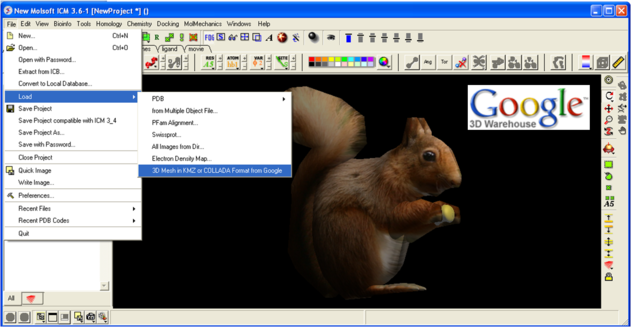
3.4.5.5 Mesh Options. |
A number of options relating to meshes can be used by right clicking on the mesh in the ICM Workspace. This section describes some of these options.
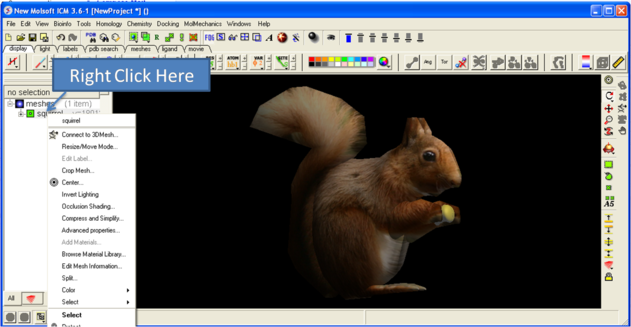
3.4.5.6 Move and Resize Mesh |
Once a mesh has been created you can move it and resize it. To do this, locate the mesh you wish to either move or resize in the ICM Workspace and right click on it as shown below.
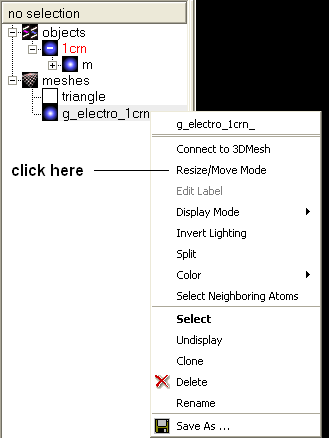
- Select the Resize/Move Mode in the menu.
A purple box as shown below will surround the molecule.
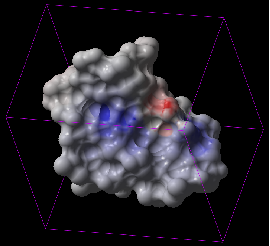
To resize the mesh click on one of the corners of the box and drag to the required size. The number displayed on the edges of the box represent the dimensions.
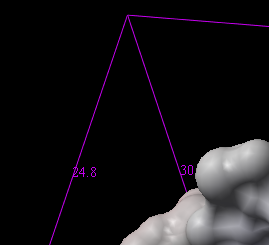
To move the mesh click on it with the center mouse button or selct the connect option.
3.4.5.7 Color and Mesh Display |
There are a number of options to color and change the display of the mesh. These options can be accessed simply by right clicking on the mesh name in the ICM Workspace as shown below.
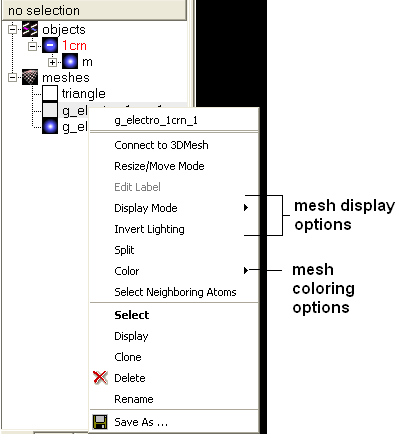
The lighting and display can be changed by selecting the options 'Display Mode' or 'Invert Lighting'.
There are five different display modes as shown below:
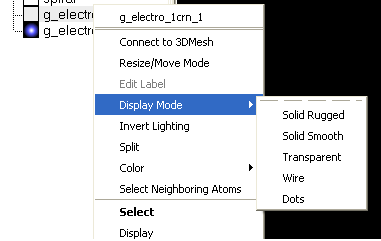
To change the lighting effects select 'Invert Lighting'.
The mesh colors can be changed by using the 'Color' option in the menu.
3.4.5.8 Mesh Clipping |
Clipping tools can be used to adjust the frames of the mesh independently of other objects.
The buttons shown below can be used for this purpose.
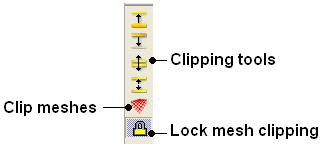
The buttons used for clipping are described in the section entitled Clipping Tools.
3.4.5.9 Save Mesh |
You can save a mesh as a wavefront object by right clicking on the mesh in the ICM Workspace and selecting SaveAs.
3.4.5.10 Occlusion Shading |
The occulusion shading option provides better representation of depth within a cavity. The color of each surface element of a grob (mesh) is changed by mixing its own color with the background depending on the burial of the surface element
To add occlusion shading:
- Right click on the mesh in the ICM Workspace and select Occlusion Shading.
- Enter a depth value - default is 0.8. Higher values will generate a more dramatic shading.
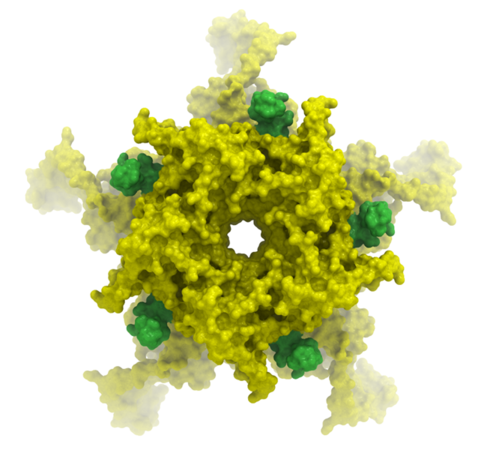
| Prev Windows Menu | Home Up | Next How To Display |